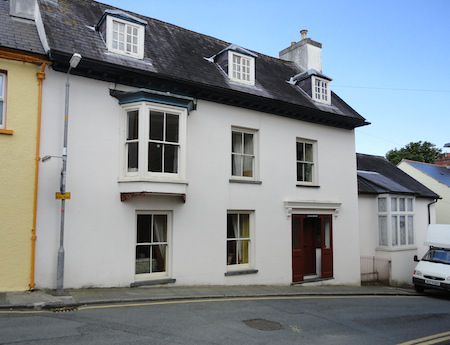The Plague comes to Pembrokeshire
Page added 22nd March 2016

Rock House, former pest house
Three years after Cromwell had ordered the destruction of Haverfordwest Castle (1648) and two years after King Charles I had been executed (1649), which finally signalled an end to seven years of Civil War horror, the plague came to Pembrokeshire.
It came to Haverfordwest on one of the ships that frequented the town port and seems to have been carried from Dublin where it was ravaging the whole of Ireland, to Bristol and thence on to Haverfordwest in late 1651.
February 1652 the Town Council was documenting the spread, which was gradual, and three or four houses were being watched where it was suspected that the disease had taken hold.
The first record that we have of plague being in the town is in February 1652. It is a horrible account of the widow Howell, wife of the deceased Owen Howell. She had been sealed up in her house with her maid and her children. But when Hugh Rice, a neighbour asked her how things fared, she threw things out of a gap in the window and on being chastised by him that she shouldn’t endanger the lives of other people in the town, her answer was that she was being treated worse than a whore and that she had the intention of throwing her children’s excrement out of the same gap in the window. It was found necessary to add extra chains to her backdoor and a smithy was sent for.
Once the word plague had been mentioned, the County JPs, to give them credit, had sought to seriously impede the movement of people to markets. But by March with nothing major appearing that might indicate an epidemic and anxious to keep fairs and markets within the town open, especially as the state of the town was so impoverished after the war, discussion led to the ‘country people’ being allowed to attend markets. The exceptions to this were Rudbaxton, Prendergast and Boulston where plague had been found and where watchers were ordered to keep those infected in their homes.
Almost immediately it became apparent that far from having eased or even faded out, the plague was about to take a much firmer grip. The markets were closed again and substitute markets and fairs were organised in Llawhaden and Steynton.
In April Thomas Davids, the mayor left for London. His reasons, he suggested, were to try and get Parliament’s tax burden on the town lowered but he also felt the need to explain to the remainder of the council that he hadn’t gone to try and escape from the ‘sickness’.
It is from the letters that went to and from Davids in London that a record has been left as to how the disease spread and its toll on the inhabitants. The period from April to September was devastating. Two hundred and twenty are known to have died with initially,the area around St Martin’s and the castle being the worst affected. Red crosses were painted on the doors of infected houses as well as being sealed shut and people who might have had contact with the sick were required to carry a white stick.
Hard attitudes prevailed and very often, servants who had become infected, or even family members, were ejected from the house where they had lived. To accommodate such unfortunates, ‘pest houses’ were opened. These were certainly not hospitals but were places where the victims could be placed until they died. One of these was in Cokey Street (City Road), the other in Holloway. In Holloway, Rock House, the home of Richard Blacklaw Jones and his family, is traditionally considered to have been the pest house.
Markets were closed for a second time. Tar coats were hired at the enormous rate of seven shillings and sixpence per week to collect and bury the dead. Burial pits were dug in the area that is now Baring Gould Way although it is also considered that burials in conventional churchyard plots would have been the norm, at least in the early days.
A succession of heroes and heroines appeared who need to be remembered but who aren’t; Alderman William Bowen who organised the town in its most dire need and got food to the sick; Reverend Stephen Love who got outlying villages to leave food at the town gates; the surgeons who remained and administered what was available for the time; and the remarkable and anonymous ‘stranger woman’ who gave care to the sick and dying.
In November, as suddenly as it had appeared, the plague seemed to have run its course and disappeared. The town was left to try and return to normality.
Over the years Rock House has been sympathetically renovated by Richard Blacklaw Jones. It is an ongoing process which continues to reveal clues as to its long rich past. And it is a process, which despite being one close to his heart, has removed, he says, any free time and emptied his wallet.